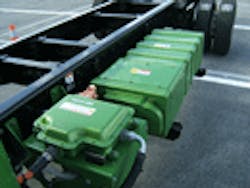Battery breakthrough needed for EV, hybrid success
A new study by The Boston Consulting Group (BCG) concludes that a major breakthrough in battery technology is necessary in order to foster “mass market” demand for all-electric and hybrid electric vehicles within the next decade. Without such a breakthrough, the firm determined, all-electric and hybrid vehicles will remain too expensive – both in terms production costs and sticker price – to penetrate the market in large numbers.
“For years, people have been saying that one of the keys to reducing our dependency on fossil fuels is the electrification of the vehicle fleet,” said Xavier Mosquet, leader of BCG's global automotive practice and a co-author of the study. “The reality is electric-car batteries are both too expensive and too technologically limited for this to happen in the foreseeable future.”
BCG’s report Batteries for Electric Cars: Challenges, Opportunities and the Outlook to 2020 is based on an analysis of existing electric car battery research and interviews with more than 50 battery suppliers, auto OEMs, university researchers, start-up battery-technology companies, and government agencies across Asia, the U.S., and Western Europe.
BCG’s research concludes that the long-term cost target used by many carmakers in planning their future fleets of electric cars – batteries that cost $250 per kilowatt-hour (kWh)of capacity – isn’t attainable with current technology. Lithium-ion batteries are the target technology for all-electric and hybrid vehicles over the next decade, the firm noted, with the goal being batteries that are lighter and more powerful than the nickel-metal hydride (NiMH) batteries currently used today in hybrids such as the Toyota Prius. Lithium ion technology is the basis for the next generation lithium-nickel-cobalt-aluminum (NCA) batteries for all-electric and hybrid vehicles, BCG said.
Citing the current cost of similar lithium-ion batteries used in consumer electronics – about $250 to $400 per kWh – many OEMs hope that the cost of an automotive lithium-ion battery pack will fall from its current price of between $1,000 and $1,200 per kWh to between $250 and $500 per kWh at scaled production, said Mosquet.
However, he pointed out that consumer batteries are simpler than the ones used in all-electric and hybrid vehicles and face significantly less demanding requirements, especially regarding safety and life span. So actual battery costs for automotive use will likely be higher than OEM predictions, he said.
“In our research, we’ve determined that consumers will begin to favor alternatives to the internal combustion engine (ICE) at about a three-year payback cycle – that is the sweet spot,” Massimo Russo, a BCG partner and co-author of this report, told FleetOwner. “Right now, with alternatives at an eight, nine, and 10-year payback cycle without any government incentives included [that price] creates a pretty significant hurdle.”
BCG’s analysis suggests that by 2020 the price that OEMs pay for NCA batteries will decrease from current levels of $990-$1,220 per kWh to $360-$440 per kWh, or about 65%. That would put the cost for a 15-kWh NCA range-extender pack around $6,000 at the OEM level, compared to the current $16,000 price tag, the firm noted. At the consumer level, the price should fall from $1,400-$1,800 per kWh to $570-$700 per kWh, or down to $8,000-$10,000 for the same pack.
“Even in 2020, consumers will find this price of $8,000 to $10,000 to be a significant part of the vehicle's overall cost. They will carefully evaluate the cost savings of driving an electric car versus an ICE-based car against the higher up-front cost,” Russo said. “It will be a complex purchase decision involving an evaluation of operating costs, carbon benefits, and potential range limitations, as well as product features.”
Though government incentives can encourage initial adoption, Russo said, at some point they must be eliminated due to their cost. “When we’re talking large scale sales of all-electric and hybrid vehicles, incentives are just not feasible,” he said. “The vehicles have to stand on their own in terms of cost benefits in relation to the impact of [gasoline and diesel] fuels on cost of operation and reduction in maintenance expenses.”
BCG believes that pending a major breakthrough, batteries will continue to limit the driving range of fully electric vehicles to about 160 to 190 miles between charges. As a result, fully electric vehicles that are as convenient as ICE-based cars – meaning that they can travel 312 miles on a single charge and can recharge in a matter of minutes – are unlikely to be available for the mass market by 2020.
“In view of the need for a pervasive infrastructure for charging or swapping batteries, the adoption of fully electric vehicles in 2020 may be limited to specific applications, such as commercial fleets, commuter cars, and cars that are confined to a prescribed range of use,” Mosquet said.
More expensive batteries, however, might not be a disadvantage if they provide more energy storage and allow for extended range, Russo said. “The question is, do you offer a lower cost, lower energy density battery, or a more expensive model that pushes an all-electric vehicle’s range beyond 160 to 190 miles?” he said. “If we can get either of those options, it will help the market for all-electric and hybrids expand. But with technology that exists right now, we can’t see that happening by 2020.”
About the Author
Sean Kilcarr
Editor in Chief
Sean Kilcarr is a former longtime FleetOwner senior editor who wrote for the publication from 2000 to 2018. He served as editor-in-chief from 2017 to 2018.
